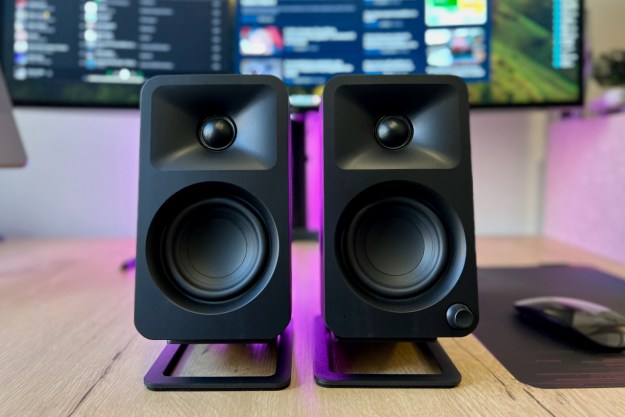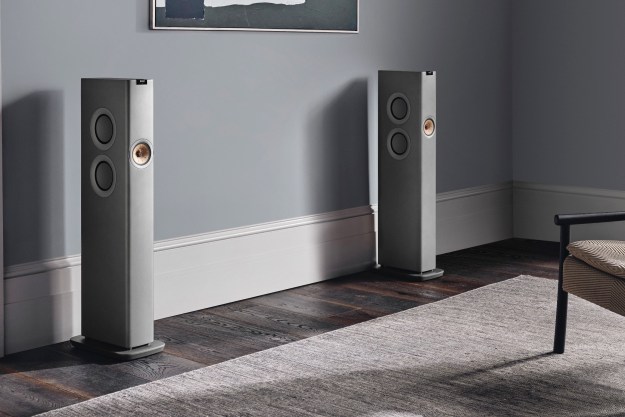
“Don't let these tiny boxes fool you. The Kanto Ora powered Reference Desktop Speakers are crystal clear and balanced-sounding audio beasts”
- Small, discreet footprint
- Impossibly clear reference sound
- Mids and highs that shine
- Killer low-end, especially with a sub
- 100 watts of power
- USB-C and Bluetooth connectivity
- A bit pricey
- No Bluetooth aptX support
- An optical input would be nice
- Doesn't come with cables
Sound this good shouldn’t come from a set of speakers that you barely know are there, but Kanto’s diminutive Ora Reference Desktop speakers defy that notion. Kanto is no stranger to squeezing big sound from small packages, so it should surprise no one that the Ora deliver some of the clearest, fullest, and most immersive sound I’ve ever heard from a set of desktop speakers, even if they are a bit pricey at $350.
But the Kanto Oras aren’t just desktop speakers, they’re reference speakers. For non-audiophiles, this means that they’re designed to deliver music exactly as it was recorded, with an accurate, flat frequency response and sound that is uncolored. While this makes them perfect for things like sound mixing or video editing, don’t you worry, games and music can get impressively loud and downright rumbly, especially when you add a subwoofer to the mix.
Sure, there’s no spatial audio support, and if you want to EQ things, you’ll need to do it with an app or at your sound source if you can, but with Bluetooth, RCA line level, and USB-C inputs, you can connect just about anything you need to turn your desktop into an excellent sound station for your office or small room. I spent a few weeks with the Kanto Ora speakers, and here’s what I thought.

Kanto Ora: design and build
Taking the Kanto Oras out of their box was a bit shocking. Each speaker is about the size of a small box set of books or DVDs, coming in at just around 7 inches tall, 4 inches wide, and 5.6-inches deep. They’re light, too, at just over 2 pounds each, and there’s not much to them when looking at them. The plastic cabinetry feels a bit chintzy, and it would have been nice if they came in a finish other than black, but honestly, once they were tucked in behind my computer monitor, they more or less disappeared anyway.
The discreet design continues on the front face of each speaker, which feature a ¾-inch silk dome tweeter and a 3-inch woofer. The primary speaker (the right one) has but a single volume dial on the front that also acts as an input selector when pressed. The back of the primary speaker houses all the inputs and outputs — an RCA line in for any analog devices you want to connect, such as a turntable (you’ll need a phono preamp though), a USB-C input for connecting to a computer for up to 16-bit/48kHz playback, and the subwoofer-out port. Here, you’ll also find the Bluetooth pairing button, as well as the DC power input and a four-pin speaker connection.
- 1. The inputs of the Kanto Ora speakers
- 2. Power and speaker-connection cables
Kanto was kind enough to also send over a couple sets of mini speaker stands, and there are also rear, threaded mounting holes for installing the speakers on the wall. I set the speakers up on the smaller, Kanto S2 desktop stands horizontally under and just behind my computer monitor about three feet apart, and other than adding to the mess of wires behind my desk, they didn’t clutter things up at all.
My only gripe is that the Oras don’t come with any cables other than the power and speaker-connection cables, which is fine for me because I have drawers full of wires, but for most people, and considering the price, maybe Kanto could have ponied up for a set of RCAs and a USB-C.
Kanto Ora: Sound quality
My first listen with the Kanto Oras was a textbook exercise in not judging a book by its cover. With 100 peak Class D watts under the hood (50 watts of bi-amplified power per speaker), they are mighty, even though they are small. I listened to the Oras through all connection options via my MacBook Pro and my iPhone. I didn’t try them with a turntable, although I’m sure it’d be an OK match, I felt like there are much better options if that’s what you want to do. I do wish that the speakers supported a higher-res Bluetooth codec than the standard SBC, but the Oras still sounded great, delivering a surprisingly spacious and balanced sound for their size.

Everything from vocals to instruments were well defined, clear, and crisp with no distortion or clipping of any kind, even when giving them some volume and, make no mistake, they do have volume. The Kanto Oras shine in the mids and trebles, with excellent clarity, detail, and presence in guitars, vocals, piano, and bright cymbals that aren’t at all abrasive, even over extended listening sessions.
Sound separation and soundstaging is off the charts with the Oras, especially when listening to dynamically rich and atmospheric music such as Radiohead. The tracks Reckoner and How to Disappear Completely, with their cavernous vocals, moody strings, and precision clinging of ride cymbals, snaps, and shakers that seem to be coming from everywhere, sound almost as good from these tiny speakers as they do from a set of quality headphones or much larger speakers.
On their own, the Oras present the low end excellently, finding its perfect place among the well-balanced and never harsh mids and highs. But add a subwoofer, and ooh. With its automatic active crossover, plugging the RCA sub cable to the Oras automatically reduces the bass load on the speakers, shifting it to the sub to do all that bassy heavy lifting. It took a minute to find the right volume balance, but once I got it dialed in, the combination just sang at any volume, wasn’t boomy, and you couldn’t tell there was a sub under my desk at all.
My favorite test with the Oras was, as clichéd as it sounds, Phil Collins’ 2015 remaster of In the Air Tonight on Tidal. I first did a pass without the subwoofer, and while the little 3-inch drivers did a remarkable job at handling all of Collins’ nuanced percussion and reverberating vocals in the first two thirds of the track, with the sub connected, I was utterly blown away with the volume and impact they managed to produce, especially when that part hits. You know the one.
With the volume nearly as far as it would go, my office literally rumbled. And while most of it was supplied by the sub, I was shocked at how well the Oras kept up with it, as if it was coming from a cohesive unit.

Kanto Ora: bottom line
For $350, the Kanto Oras might, at first, seem too pricey for such a small set of desktop speakers. But their balanced reference speaker sound, clarity, and surprisingly big 100 watts of power in such a discreet package more than justify the price.
Are there alternatives? Of course. The Audioengine A2+ are highly rated, have similar inputs, and feature aptX Bluetooth for $80 less. But they’re significantly less powerful. You could also check out the 90-watt Fluance Ai41 powered, 5-inch bookshelf speakers that are $250, come with a remote and in a range of nice finishes, and have a digital optical input for connecting to a TV, if you like. Kanto’s own YU4s, while a bit more expensive at $420, would also be a good option.
The beauty of the Kanto Ora reference desktop speakers is that if you’re looking to add a set of speakers to your desktop setup, whether for professional video editing or sound mixing, playing video games, watching YouTube or Netflix on your computer, or listening to music while you work, they sound great and will not get in the way. But, if you want to go all In the Air Tonight on the situation, it’s only a few hundred dollars and a subwoofer away.
Editors' Recommendations
- Spotify’s new Desktop Miniplayer is a godsend for multitaskers
- Guess how much this tiny Porsche Design speaker costs
- This tiny Ikea waterproof Bluetooth speaker is just $15
- Amazon adds spatial audio to the Echo Studio smart speaker
- Edifier MP230 Hands-on Review: The pint-sized, retro Bluetooth speaker brings a vintage vibe







